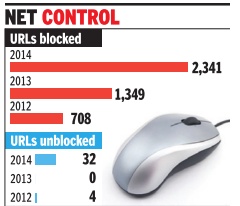Internet: South Asia
This is a collection of articles archived for the excellence of their content. |
Internet freedom: South Asia
Internet freedom improves in India
Kim Arora The Times of India Dec 05 2014
Now Ranks 30 Among 65 Countries: Study
India made a positive jump of five spots to be ranked 30 among 65 countries in a study on internet freedom by the US-based watchdog organization Freedom House.Titled “Freedom on The Net“, the report assesses internet freedom in various countries against the metrics of accessibility, limits to content, and user rights violations.
India figures in the “partly free“ category along with Rwanda, Tunisia, Singapore, and Sri Lanka. With a cumulative score of 42, India showed an improvement over last year's score of 47 (higher score indicates lower freedom). Iceland, Estonia, and Canada are the top three countries in the list. Pakistan ranks 56 while China is at number 63. Last year, India's rank on the same list was 35.
“The regulatory framework that governs the internet in India is at a pivotal moment,“ says the report, adding, “Detentions declined in the past year in the wake of negative publicity , as well as intervention from the government and Supreme Court.Several petitioners have chal lenged parts of the IT Act...as unconstitutional in the SC.The court's decision in these cases will be critical to the protection of freedom of expression online in India.“
The report also takes note of the lack of a privacy law and the government's Central Monitoring System for the surveillance of communication over the telephone and the internet. Lack of infrastructure and low digital literacy added to the “obstacles“ tally, though the study takes note of the fact that India became the third largest internet consumer base in 2013.
“There was a spate of incidents where free speech was hindered online. But now, I think more than the government, the people have become more aware and responsible about these things,“ says activist Aseem Trivedi, who was briefly jailed in 2012 for his anti-establishment cartoons.“There is room for improvement when it comes to those who manage to foment sectarian violence online,“ he says.
Bhopal-based Shubhranshu Choudhary , who is behind the digital citizen journalist program CGNet Swara, says that in terms of access, improvement is only marginal.“In the normal course of things, it is more or less the same. Yes, there are more mobile towers now, and we have bulky figures for mobile penetration. The government also seems to be talking more about digital expansion. But with Internet penetration at about 15% India remains behind,“ says Choudhary .
Digital divide
The Times of India Jan 08 2015
India saw its first internet connection on August 15, 1995 when Videsh Sanchar Nigam Limited launched the country's first internet services. The government opened up the sector for private operators in 1998. New regulations in telecom policy opened up internet telephony in 2002. Despite these measures, India's internet prevalence is far lower than in the advanced or other BRICS economies. Given the literacy levels and with average revenues per user in many cases being comparable to the cost of the cheapest internet packages offered, this is hardly surprising.
Net control

Apr 04 2015
Govt blocked 2,341 URLs in '14, 73% more than '13
The government issued orders to block 2,341 URLs in 2014, the official response to an RTI application has shown, up 73% from the number blocked in 2013. The RTI was filed by Delhi-based nonprofit legal services organisation Software Freedom Law Center India (SFLC.in) last month with the Department of Electronics and Information Technology (DeitY), which falls under the ministry of communications and IT.
The number of orders blocking URLs (Uniform Resource Locators), the address of data available on the world wide web, stood at 1,341 in 2013. The application sought answers on blocking orders issued pursuant to court orders, requests from government departments, and at the suggestion of private parties. The DeitY response says that “barring a few numbers, all URLs were blocked on the orders of the court.“ “Further, as per the provisions of Rule 16 of the Information Technology (Procedure and Safeguard for locking for Access of Information by Public) Rules, 2009, notified under section 69 A of the Information Technology Act 2000, the requests and complaints received and ac tions taken thereof are confidential,“ the reply adds.
SFLC.in, which uploaded the RTI and the reply on its website, has said in an accompanying blog that the government needs to review its stance on confidentiality, particularly in the light of the apex court's observations while striking down Section 66 A of the IT Act. It says that the SC “invited attention to several safeguards incorporated into Section 69A -one amongst them being that reasons behind blocking orders are to be recorded in writing in the orders... so that they may be challenged by means of writ petitions...“
